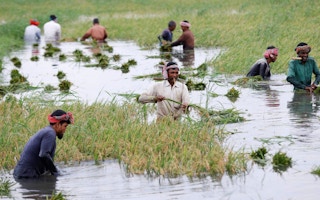Each year the country presiding over the UN Climate Summit - which this year is Egypt - can choose key areas in which to raise ambition through the ‘presidency programme’.
The news that Egypt has chosen to add an ‘adaptation and agriculture day’ at COP27 is very welcome and shows how agriculture is rising to the top of the climate agenda. But it is imperative that this delivers tangible progress towards a more sustainable global food system.
The effects of climate change are already having a severe impact on agriculture and livelihoods, with recent floods in Bangladesh devastating crops, and heatwaves in India and the United States causing reduced wheat yields and livestock deaths.
This, on top of the Ukraine crisis and the ongoing impacts on supply chains from the pandemic, means our food systems are at a breaking point. The United Nations has noted that the world is facing a global hunger crisis of unprecedented proportions in 2022 – and we are at a critical crossroads where we need action.
A coalition of investors representing $14 trillion of assets, backed by ex-UN climate chief Christiana Figueres, has recently called on the UN Food and Agriculture Organization (FAO) for a clearer roadmap for agriculture and land use to 2050 aimed at limiting global warming to 1.5°C.
Importantly, this letter highlighted the need to align climate goals with nature, health and food security goals while ensuring a just transition for vulnerable communities.
The roadmap would be valuable for policymakers as well as investors, civil society organisations and food companies themselves. Like with the IEA Net Zero by 2050 roadmap for the global energy sector, having a clear roadmap to show how agriculture can meet the Paris climate change goals will be essential.
Why is action on climate and nature so important for the resilience of food systems?
Even warming of 1.5°C poses significant risks for food systems. The Intergovernmental Panelon Climate Change’s new Working Group II report estimates that up to 10 per cent of the land area that is currently used for cultivation of major crops and livestock will be climatically unsuitable by mid-century.
This loss of agricultural capacity won’t just affect global food supply, but also the people that depend on farming this land for their livelihoods.
What’s more, scientists have highlighted that we must protect nature to support our resilience to climate change impacts. Nature can act as a buffer to climate extremes – for example, coral reefs and mangroves help protect from the impacts of sea level rise, with mangroves storing more carbon than any other forest ecosystem on earth.
Intensive agriculture also creates major risks for nature. If we do not address climate, biodiversity, and food security goals together, we may end up heading in the wrong direction – such as using land for biofuel, or an excessive use of carbon offsets that allow companies to continue with almost business as usual, a path fraught with major risks for agricultural land, food prices, and vulnerable communities.
There are strong synergies between both reducing emissions and becoming more resilient. These win-win-win outcomes for climate, nature, and food security and will ensure we can meet the climate goals while providing nutritious food for a growing global population.
The pathway to COP27
To address the multiple challenges the world is facing, there is also an urgent need to scale up private and public funding towards sustainable food systems. A UN-mandated roadmap to 2050 for agriculture and land use could help mobilise this capital, and guide investment in the right direction, including subsidies from the public sector.
Currently, only a small portion of public climate finance goes to agriculture, and these flows are likely inadequate to meet global climate goals. According to the development banks’ joint report, only 6 per cent of the development bank finance for reducing emissions and 7 per cent of adaptation finance in 2021 went to agriculture.
Now is the time to shift attention towards sustainable and resilient agricultural systems which are vital for livelihoods and food security in the face of climate impacts.
It is welcome to see the Egyptian Presidency is rightly focusing on issues around agriculture and resilience as it relates to climate action at COP27. We also know that time is running out to meet the 1.5°C climate goal.
By focusing on agriculture, COP27 offers an opportunity to strengthen resilience, enhance food security for the most vulnerable, and guide us towards a sustainable path to 2050.













